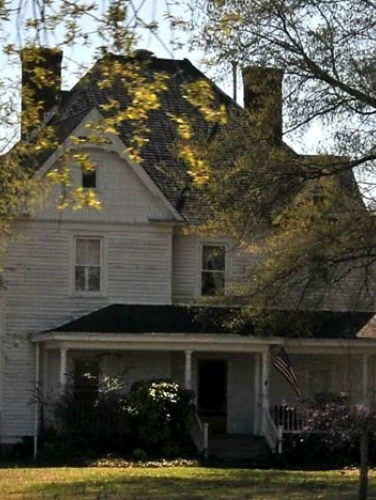
S. W. Davis House & Outbuildings
(ca. 1903)
Silas W. Davis, the original owner of the S. W. Davis House, played a prominent role in the life and development of the Croft community.
9132 Bob Beatty Rd, Charlotte, NC 28269
The Queen Anne style S. W. Davis House was the home of Silas Winslow Davis (1873-1925), a prominent farmer in the small community of Croft, located on the railroad line between Charlotte and Huntersville. With his brother Charles Spencer Davis (1868-1945), Silas was also co-owner of the now-century-old S. W. & C. S. Davis General Store (ca. 1908), Mecklenburg County’s best preserved general store.
Property Quick Links
Despite its small size – the National Register Historic District of Croft has only twenty-one contributing structures (including the S. W. Davis House, the Davis brothers’ general store, and the Croft Schoolhouse) – Croft would have never developed without the railroad. The train tracks that run through Croft were once part of the Atlantic, Tennessee & Ohio (AT&O) Railroad that connected Charlotte to Huntersville and points beyond. Completed in 1863, the line was soon disassembled and re-laid to supplement the wartime needs for a railroad between Greensboro, North Carolina, and Danville, Virginia. The AT&O leg between Charlotte and Huntersville was restored in its entirety by 1871. The railroad and the Davis general store soon became important social and economic forces in the area.
Silas married Nancy Jane Black in 1895. They hired local carpenter Neil Barnett to construct the Davis House in 1903, where the couple raised their ten children. The proximity of the AT&O Railroad also aided in the construction of the Davis House. Industrialization in the United States allowed large factories to mass produce wire nails, doors, windows, siding, and decorative details that could then be transported throughout the country by rail. Examples of such elements within the Davis House include the dormer with its decorative details and the decorated cross-gables of the varied roofline. According to local accounts, the lumber used in the house was cut and mill on site. Brick for the chimneys, supporting piers, and two brick outbuildings on the property are said to have been produced from the brick yard behind the Davis store. The two brick outbuildings, a flower house and a spring house, provide outstanding examples of early twentieth-century brickwork.
Charles worked primarily as a retail merchant, but Silas Davis combined farming and retailing throughout his adult life. He grew cotton, corn, wheat, and oats with the assistance of his children and tenant farmers who lived and worked on the farm. Silas also raised a variety of fowl and livestock, some of which he would routinely slaughter and sell as fresh meat in the general store.
In the 2010s, the Davis House was incorporated – along with the neighboring Croft Schoolhouse – into the campus of the Pioneer Springs Community School.

